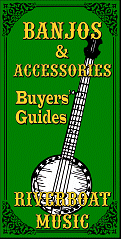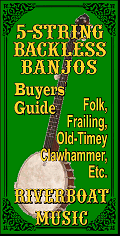Acoustic Instrument
Primers
What Kind of Guitar
Should I Start On?
What Kind of Banjo
Do I Want?
Evaluating and
Buying Used
Guitars
Setting Up
Fretted Instruments Whatever Happened
to the Banjo?
Beginning Five-
String Folk Banjo
6-String Banjos
Banjo Pickups
Axes in my Life
What is a
Bluegrass Banjo?
Dean "Backwoods
Six" Shootout
What is a Zither Banjo?
Music Theory
Primers
Introduction
to Scales
Introduction
to Chords
Circle of Fifths
Other Articles
About Music
How to Give
Guitar Lessons
Musician or
Wannabe? Did God Really
Give Rock &
Roll to You?
Are You a
"Brand Bigot"?
Who Owns Folk Songs?
Historical Links
About the
National Road
The Story Behind
the Story - Real
People, Places,
and Events
About the Play
Play Home
What's New
Overview
About the
Music
About the
History
About the
Logistics
About the
Cast
Synopsis
About the
Set
About the
Author
Contact Us
Home

Lesson 1d: Basic Chording Techniques
| Edited by Paul Race for Creek Don't Rise? |
|
Editor's Note: Between 1999 and 2004, Mitchel "Mickey" Cochran posted an extensive collection of free musical instrument lessons on his FolkOfTheWood.com web page. Sadly, we lost Mickey in 2011. After e-mailing surviving family members for permission to repost some of Mickey's most popular materials, we have begun restoring them to host on these pages. (Please see the Introduction page for more information on that effort.) This page is Mickey's explanation of hot to get started learning chords on the 5-string banjo tuned in "Open G Tuning," the Bluegrass favorite. - Paul Race |
Lesson 1d: Basic Chording TechniquesChords are the building blocks of songs...and, lay down the harmonic structure of a song with harmony notes that support the melody. Chord playing also is required when playing back-up to vocalists or other instrumentalists. Chords are built from musical intervals...that in turn, create a harmonic structure which denotes the key of the song. For instance, a major chord is built on 3 tones called a major triad. In the key of C this consists of the scale intervals of 1 3 and 5. Or C, E and G. With these three notes you'll have a C chord...with this type of knowledge, you can build your own chords. For the G major chord, you would have G, B and D...again the 1, 3 and 5 of the G major scale. This is only the surface of how chords are built. I highly recommend that you purchase a music theory book and do your own research...having music theory knowledge will greatly enhance your learning process. In our
discussion of building chords, we'll also want to consider what are key
structures...this way, we'll be better able to determine which chord is
played within a song's context. Once you know the key of a song, you can
better find the chords yourself. For instance, in the key of C, there
are three common major chords: C, F and G...and, 90% of the time, these
chords will be all that comes into play. In genres such as rock, country
and bluegrass you usually only find that the 3 common chords, to an
individual key, would be all that you need to know. In jazz or
classical, there are many more passing chords. This type of music theory
will give you far more flexibility when you find yourself in a jam
session...where songs are called up out of the air of which you may have
never played before...with this music theory within your reach, you'll
find yourself easily adapting to most any musical setting.
Note from Paul: There is more information about how chords are made and how chords go together in songs in the following two pages:
Some of the information in those two resources "jumps" ahead of what Mickey is presenting in this lesson, but please consider bookmarking them as a reference as you proceed through this training. In learning to play chords, you'll want to follow a few points of reference: 1. Take your time, and learn one chord at a time... 2. Memorize the pattern of where the chord falls into place on your fingerboard. You'll want to be able to quickly put down the fingers all at once...you do not want to place one finger at a time. 3. Be careful to use the very tips of your fingers...the fingers should come down straight on the fingerboard so that you're not touching adjacent strings. If you're touching adjacent strings, you'll have some dead notes when strumming or picking the chord. 4. Play each chordal note directly behind the fret with the tip of your finger. Do not play in between the frets...move your fingers all the way up behind the fret being played. This ensures a clear note with good pitch. 5. Do not add too much pressure when playing the note. If playing directly behind the fret, you'll find it doesn't take too much added pressure to create a clear note (if it does, your action may be too high). Note from Paul: Our article Beginning Five-String Folk Banjo - Part One - Introduction to Banjo Chords explains some of this content as well, with a few more illustrations and a video you may find helpful. Here are some major keys and the chords required to learn within that key: Key of C: C - F - G Relative minor chord: Am Key of G: G - C - D Relative minor chord: Em Key of D: D - G - A Relative minor chord: Bm Key of A: A - D - E Relative minor chord: F#m The above chord positions will be taught in future lessons...this is only to give you an overview of the many chordal positions ahead of you. By memorizing one key structure at a time, you'll find it becomes easier and easier as your progressively advance in your lessons. Notice above, that once your memorize the key of C chords, that you've already learned one chord for the key of G...and once you've learned both the keys of C and G, you'll have two of the chords already memorized for the key of D. Hence, do not become discouraged with what's ahead of you...you're going to find that the learning process is cumulative and becomes easier as you advance. Mickey Some further Questions and Answers: Date: Sat, 20 Mar 2004 09:49:54 -0800 (PST) Delivered-To: folkwood@stephano.zianet.com |
Conclusion
Mickey's instructions are as valid today as when he wrote and recorded them years ago. Here's hoping that you find them just as helpful as his original followers did back when he was interacting on a daily basis with his them.
Please contact us if you're hitting any brick walls and we'll try to help you get therough them.
Best of luck, all, enjoy your music, and support the arts.
Paul Race
And when you're ready to move on, click here to go to the next part of this online lesson.

|

|


All text and any illustrations and/or videos within the white box above are copyright 1999-2004 by Mitchell Cochran. All other materials, illustrations, and content on this web page, including the text reformatting and illustration restoration within the white box are copyrighted ? 2016 by Paul D. Race. All rights reserved.
Creek Dont' Rise(tm) is a participant in the Amazon Services LLC Associates Program, an affiliate advertising
program designed to provide a means for sites to earn advertising fees by advertising and linking to Amazon.com.
For questions, comments, suggestions, trouble reports, etc. about this page or this site, please contact us.
| Visit related pages and affiliated sites: | |||||
| - Music - | |||||

|
 |
 |

|

|

|

|

|

|

|

|

|

|

|

|

|

|

|
| - Trains and Hobbies - | |||||
 |

|

|  |
 |

|
| - Christmas Memories and Collectibles - | |||||
 |

|
 |

|
 |

|
| - Family Activities and Crafts - | |||||
 |

|

|

|

|

|
